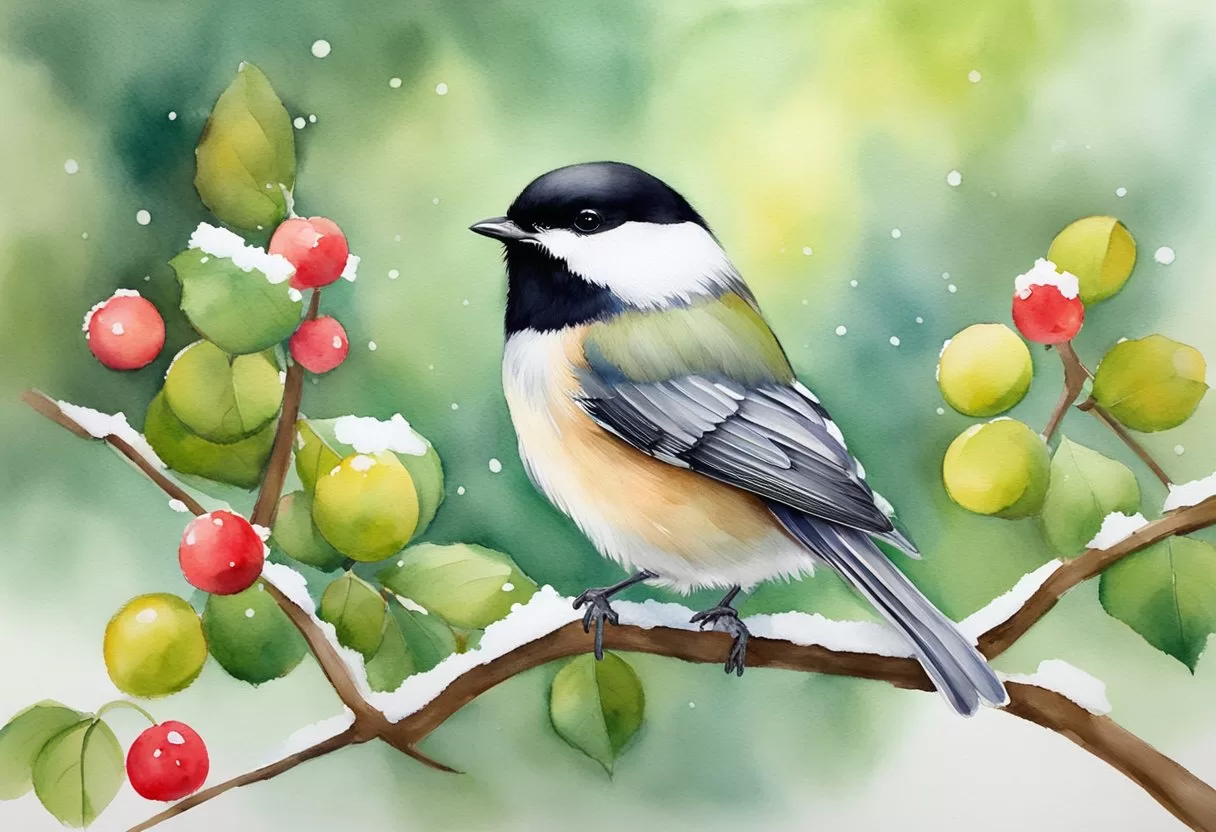Understanding Chickadee Behavior Across Seasons
Chickadees exhibit various behaviors influenced by seasonal changes, highlighting their remarkable adaptability. Key aspects include physiological adaptations that help them survive winter conditions and significant shifts in their metabolism and activity levels due to changes in daylight.
Adaptations to Seasonal Change
The black-capped chickadee (Poecile atricapillus) shows several adaptations to cope with seasonal impacts. During winter, these birds build up significant fat reserves, essential for energy conservation, as food becomes scarce. The ability to enter a state of torpor allows chickadees to lower their metabolic rate, thus reducing energy expenditure on extremely cold nights.
In this state, they can conserve heat and sustain themselves longer without food. They also engage in social behavior, forming flocks that not only provide protection from predators but also enhance foraging efficiency. This communal living is crucial for surviving the harsh winter environment where temperatures can lead to hypothermia if food is insufficient.
Shifts in Photoperiod and Metabolism
Changes in daylight trigger metabolic shifts in chickadees. Photoperiod influences the timing of breeding, migration, and foraging behaviors. During the longer days of summer, metabolism increases, facilitating higher energy demands from foraging. The bird’s activity peaks in spring, aligning with the abundance of food sources, supporting both energy and reproduction.
As daylight decreases in winter, metabolism slows, enabling the chickadee to survive on less. This adaptation allows it to match its energy budget with available resources. Learning to optimize feeding strategies is vital; chickadees often cache food, hiding it in multiple locations to retrieve later. This strategic behavior underpins their survival across seasonal shifts in their environment.
Behavioral and Cognitive Responses

Chickadees exhibit specific behavioral and cognitive adaptations that enhance their survival during seasonal changes. These adaptations manifest in memory function, communication through vocalizations, and social dynamics within their groups. Each aspect plays a crucial role in their ability to navigate challenges presented by different seasons.
Memory and Hippocampus Function
The memory capabilities of chickadees are significantly influenced by seasonal conditions. Research indicates that wintering chickadees demonstrate enhanced memory performance compared to their summer counterparts. This improvement is often linked to the increased density of neurons in the hippocampus, the brain region critical for memory formation.
During winter, the need to locate caches of food becomes paramount. Chickadees store food in various locations and rely on their memory to retrieve these items later. In colder environments, they employ spatial memory strategies to navigate their territory effectively. Studies show that the hippocampus of chickadees expands in size during winter months, directly correlating to their increased reliance on memory for survival.
Vocalizations and Communication
Chickadees utilize a complex system of vocalizations for communication, particularly during the harsh winter months. Their calls serve multiple functions, including signaling alarm, establishing territory, and maintaining group cohesion. The distinctive “chick-a-dee-dee-dee” call varies in intensity and length, providing information about the level of threat.
During winter, vocal communication becomes vital as they gather in flocks. Lower-frequency calls are often used to convey alertness in the presence of predators. Furthermore, the frequency and context of vocalizations can also reflect the emotional state of the bird, enhancing social interactions within the flock.
Social Group Dynamics
Social behavior in chickadees is closely intertwined with their survival strategies. In winter, they form flocks that consist of 6 to 12 individuals. This social structure not only improves foraging efficiency but also offers protection against predators. The dynamics within these groups are characterized by both cooperation and competition.
Chickadees display a dominance hierarchy that influences access to food and other resources. Such hierarchies, established through interactions and vocalizations, help to reduce conflict within the group. The social bonds formed during this period are crucial for maximizing survival, allowing them to thrive even in the face of adverse winter conditions.
Survival Strategies and Threats
Chickadees face multiple challenges throughout the year, including predation and variations in breeding behavior. Their survival strategies are adapted to seasonal changes, allowing them to thrive in diverse conditions while mitigating risks.
Predation Risk and Roosting Habits
Predation remains a constant threat for chickadees, especially during winter months. Common predators include hawks, weasels, and domestic cats, which can significantly impact local populations. To minimize risks, chickadees often congregate in mixed-species flocks, enhancing vigilance through social behavior.
Roosting habits play a crucial role in survival during colder periods. Chickadees tend to select dense foliage or tree cavities for roosting to reduce exposure to harsh weather. They also exhibit behaviors like shivering to generate warmth and conserve energy during freezing nights. Internal fat reserves accumulated during foraging help them endure when food is scarce.
Mating Behaviors and Breeding Season
The breeding season presents unique challenges, particularly for inexperienced males. Research indicates that they may provide less food to their mates during critical periods like egg-laying and incubation, negatively affecting juvenile recruitment. This can lead to lower survival rates for fledglings.
Chickadees typically breed in late winter to early spring. Mating pairs often form strong bonds, reinforcing cooperative behaviors essential for feeding and protecting their nests. Predation risk increases during this time, prompting females to choose nesting sites that offer better camouflage and security. Proper selection of these sites is vital for the survival of their offspring.
Share this content:

Post Comment
You must be logged in to post a comment.